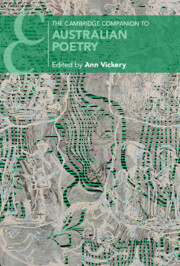Book contents
- The Cambridge Companion to Australian Poetry
- The Cambridge Companion to Australian Poetry
- Copyright page
- Contents
- Figures
- Contributors
- Acknowledgements
- Chronology
- Introduction
- Part I Change and Renewal
- Part II Networks
- Part III Authors
- 9 High Delicate Outline
- 10 Burning Sappho
- 11 Les Murray
- 12 Lionel Fogarty’s Poetics of Address and the Negative Lyric
- Part IV Embodied Poetics
- Part V Expanding Form
- Further Reading
- Index
- Cambridge Companions To …
- References
12 - Lionel Fogarty’s Poetics of Address and the Negative Lyric
from Part III - Authors
Published online by Cambridge University Press: 06 June 2024
- The Cambridge Companion to Australian Poetry
- The Cambridge Companion to Australian Poetry
- Copyright page
- Contents
- Figures
- Contributors
- Acknowledgements
- Chronology
- Introduction
- Part I Change and Renewal
- Part II Networks
- Part III Authors
- 9 High Delicate Outline
- 10 Burning Sappho
- 11 Les Murray
- 12 Lionel Fogarty’s Poetics of Address and the Negative Lyric
- Part IV Embodied Poetics
- Part V Expanding Form
- Further Reading
- Index
- Cambridge Companions To …
- References
Summary
The chapter argues that Fogarty’s lyric “I” emerges out of questioning and inverting the institutional and political forces that define his work. It traces the development of his poetry as political dialogue through the context of his childhood at Cherbourg Aboriginal Reserve, his participation in community programs, the National Black Theatre, and the emergent Australian Black Panther Party. It includes his role in the Aboriginal land rights movement, the Black Resource Centre collective, and his engagement with Black Studies courses. The chapter also outlines the reception of Fogarty’s poetry and the challenges that his resistant poetics poses to the field of ‘Australian literature.’ The chapter investigates how Fogarty creates an ecology of connections between the human and non-human, distinguishes his writing from a prior generation of Aboriginal writers, fostered inter-Indigenous and cross-cultural connections internationally, and has many intimate addresses, including poems to his brother, whose death in custody triggered political marches and has tragic resonance today.
- Type
- Chapter
- Information
- The Cambridge Companion to Australian Poetry , pp. 197 - 216Publisher: Cambridge University PressPrint publication year: 2024

